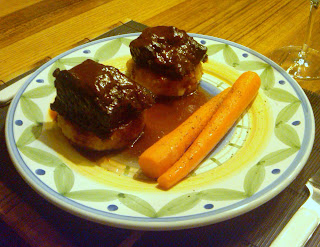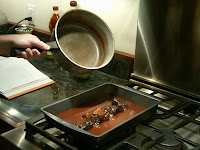 We adapted this recipe from Michel Richard’s Happy in the Kitchen. Like many of Richard’s recipes, making these short ribs is a long and involved process (it takes two days and requires 20 different ingredients). The techniques employed and the equipment required, however, are both simple and familiar. Just remember to set aside plenty of time, and this recipe can be a lot of fun, and very rewarding.
We adapted this recipe from Michel Richard’s Happy in the Kitchen. Like many of Richard’s recipes, making these short ribs is a long and involved process (it takes two days and requires 20 different ingredients). The techniques employed and the equipment required, however, are both simple and familiar. Just remember to set aside plenty of time, and this recipe can be a lot of fun, and very rewarding.
What really sets this recipe apart from your average short rib is the quality of the sauce. Smooth and rich, with complex flavor, the sauce is a thing of beauty. Syrah, which forms the base of the sauce, has plenty of depth and power to match up against the richness of the short rib. The star anise we include in the bouquet garni helps to highlight the sweet elements in the sauce. Finally, port and honey are added to the sauce at end to temper any harshness in the wine.
 |
| Skimming fat off reducing sauce |
Just as important as what goes into the sauce, however, is what gets taken out of it – the fat. After refrigerating the short ribs overnight, most of the fat in the sauce will have risen to the surface and formed a hard layer. Make sure to remove as much of the fat from the surface of the sauce at this stage as you can. Be patient. After straining the solids out of the sauce, we bring it to a simmer and then move the saucepan to one side of the burner. Boiling the liquid in only one side of the pan pushes the foam that rises to the top to the opposite side, making it easier to skim off. This is a neat trick to use whenever you need to skim fat off the surface of a sauce as it reduces.
This recipe calls for browning the short ribs in clarified butter. Clarified butter is simply regular butter with the milk solids removed – and is terrific for browning meats. When heated to higher temperatures, the milk solids in whole butter can burn. By browning the meat in clarified butter, we can achieve the same deep brown crust that I associate with meats browned in butter, without all the smoke (good news for those of us with sensitive smoke detectors). I’ve included instructions on how to make clarified butter in the recipe.
Short Ribs Braised in Syrah
Ingredients
8 tablespoons (1 stick) unsalted butter
 4 beef short ribs, about 7 inches long and 2 inches wide
4 beef short ribs, about 7 inches long and 2 inches wide
Kosher salt
1 tablespoon olive oil
6 ounces slab bacon, cut into ½ inch pieces
1 cup diced leeks (white and light green parts)
2 cups diced yellow onions
1 cups diced carrots
6 garlic cloves, peeled
1 bottle Syrah
2 cups chicken stock
1 tablespoon black peppercorns
 2 star anise
2 star anise
2 6-inch pieces leek green
2 bay leaves
3 sprigs thyme
2 sprigs rosemary
1 cup ruby port
1/8 cup honey
½ cup tomato paste
Freshly ground black pepper
Instructions





- Melt the butter in a small saucepan over low heat, without stirring. Once the butter has completely melted, skim off the foam that has risen to the surface and discard. Carefully pour off the clear yellow liquid underneath. This is the clarified butter. Discard the white milky layer left in the bottom of the pan.
- Position oven rack in lower middle position, and preheat oven to 275°F. Dry the short ribs with paper towels, season on all sides with Kosher salt, and let sit for about 10 minutes.
- Heat 2 tablespoons of the clarified butter in a large skillet over medium-high heat. Arrange as many short ribs as can fit in the skillet without touching and cook, turning occasionally, until evenly browned on all sides, about 10 minutes. Remove browned short ribs from skillet and repeat with remaining short ribs, adding additional butter to the pan as necessary.
- Heat olive oil in large Dutch oven over medium heat until shimmering. Add the bacon and stir for about 10 minutes or until it has rendered its fat. Stir in the leeks, onions, carrots, and garlic and sauté for 10 minutes, stirring frequently, until the vegetables are wilted and lightly caramelized.
- Add about 1 cup of the wine and, using wooden spoon, scrape up any browned bits from the bottom of the pot. Arrange the short ribs over the vegetables, layering them as necessary. Reduce heat to medium-low, and add the remaining red wine and chicken stock.
- Place the peppercorns and star anise in a small piece of cheesecloth or a small coffee filter, and tie with twine to form a bundle. Lay a piece of leek green flat on the work surface. Place the bay leaves, thyme, and rosemary in the center and cover with the remaining piece of leek. Tie together with twine. (See photos.)
- Bring the liquid to a boil, skimming off any fat and scum that rises to the surface. Cover the pot and place in the oven for about 3 hours. When the meat is done, it should be fork-tender and should separate easily from the bone.
- Remove the pot from the oven and let cool to room temperature, then refrigerate overnight in the pot.
- The next day, remove the pot from the refrigerator and preheat oven to 325°F. Remove and discard all the hardened fat that has risen to the surface. If the liquid has gelled and the meat cannot be removed easily, heat the pot over medium meat. As the liquid heats, remove the meat and bones from the pot before the meat softens. Then continue to heat he liquid until simmering.
- Meanwhile, place the meat on a cutting board. Cut away and discard the bones and any fat and sinew. Place the meat in a baking dish or small roasting pan.
- Strain the cooking liquid through a fine-mesh strainer into a large saucepan and discard the solids. Place over medium heat, add the port, honey and tomato paste, and bring to a boil. Move the pan to one side of the burner and reduce the liquid to about 4 cups, skimming off the foam that rises to the top. When reduced, season the sauce with salt and pepper to taste and pour the sauce over the meat. At this point, the meat can be covered and refrigerated for up to a day.
- Place the baking dish in the oven and bake for 30 minutes. If the sauce does not cover the meat, baste the meat every 5 minutes.
- Place the meat on serving plates and spoon the sauce over the top.



























